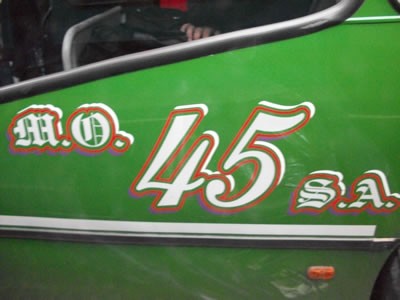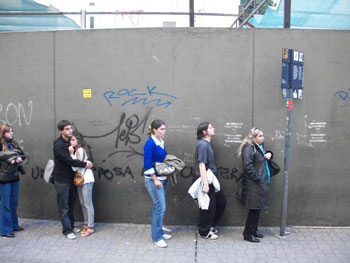The Buenos Aires bus— so noisy, so smokey, but so darn affordable and practical they’ll get you anywhere.
Here are the steps to take a bus in Buenos Aires:
1. Figure out your route
First you’ll need to figure out which bus you need using an internet site such as Buenos Aires’ interactive map, for which there is also a phone app.
There are other phone apps available that can help you figure out which bus you need, such as Moovit or Cualbondi.
2. Find the bus stop
Once you know which bus you want to take, another challenge can be figuring out where the bus stop actually is located.
On major streets such as Corrientes and 9 de Julio they are well marked. The bus stops are every two-and-half to three blocks, and usually marked with the numbers of the lines that stop there as well as a list of major stops. Just walk along the avenue or street until you see a stop.
Sometimes the bus stops are not well marked in residential areas and you will need to ask someone: ‘¿Dónde está la parada para el 24?’(Where is the stop for the 24?)
Store and newsstand owners are accustomed to answering questions about the buses because no one knows where the bus stops are if they are not familiar the area.
During the day there will often be a line of people waiting for the bus, you can ask them as well. If you don’t speak Spanish well you can also point to your bus number on your phone and offer a perplexed look to be pointed in the right direction.
3. Make sure you have a Sube smart card to pay the fare
Before getting on any bus in Buenos Aires or other cities, you need a Sube smart card, to pay the fare because the buses no longer take change or bills.
The city finally delivered on its promise to install card readers a few years ago, which has greatly reduced the need to hoard coins to pay for the bus as citizens had to do before.
It was a big problem, oh the good old days!
The basic fare for the general population costs under US$0.25 (in the peso equivalent).
Today the SUBTE smart card is what you need to ride the bus and the subway.
Sometimes there are shortages of the actual cards, so we recommend to our airport pickup customers to try and buy it in the kiosk in Ezeiza.
In the city, lottery outlets and subway stations are supposed to stock them, but you may have to go to a few before finding one.
If you can’t find a card you can give the fare to someone and have them let you pass on their card.
4. Get on line at the bus stop
Aside from rush hour on very busy avenues, there is usually just one line of people for all the buses that go by any particular stop.
Get in the back of the line.
When you see your bus coming along, identified by its number above the windshield, put out your hand to indicate that you would like to get on the bus – each stop handles several buses, so if no one on line flags the bus, it will speed on by.
Sometimes it will speed on by regardless – chalk it up to the inner complexities of the quintessential Buenos Aires bus driver.
5. Tell the bus driver where you are going
Once you are on the bus you need to tell the conductor where you are going so he or she can charge you the appropriate fare.
Simply name the cross street or location where you plan to get off, for example: ‘hasta Cordoba, por favor.’
Many passengers, accustomed to taking the same route everyday, just tell the conductor how much to charge them. M
ost fares for shorter distances around the city, from three to six kilometers, cost less than US$0.20 and they go up from there.
If you prefer you can make like a local and also just tell the driver the amount to charge, ‘dos cientos cincuenta, por favor.’
6. Pay your bus fare
After you’ve indicated your stop to the driver, hold up your SUBE smart card to the card reader next to the driver.
7. Hold on tight!
Once on board, the elderly, pregnant women and anyone with kids obviously has priority seating so if you don’t have the good fortune to get a seat take a steady stance and hold on tight for a herky jerky ride!
8. Getting off the bus
When you are ready to exit the bus, push the button located on the pole by the back door.
Be careful exiting the bus — sometimes they don’t quite get to the curb and barely stop.
If you are let off into the street, be careful to look backward toward the oncoming traffic before jumping off to make sure there are no bicycles or motorbikes speeding up from behind.

